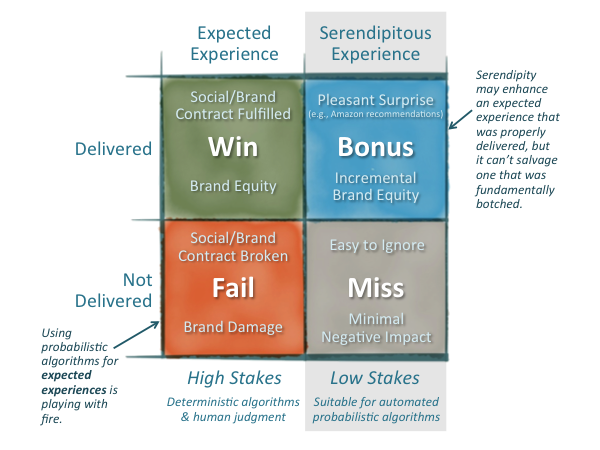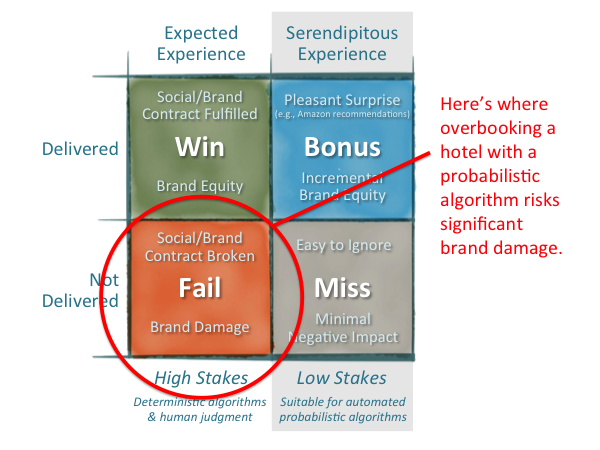
Two trends, each racing forward, that have the potential for disastrous collisions:
- The need for truly customer-centric organizations in a fully connected world.
- The use of algorithms, predictive analytics, and big data to optimize everything.
In many cases, these can be synergistic. But some are train wrecks.
I experienced just how badly those two things can clash first-hand this week, when the Westin Cleveland Downtown reneged on my supposedly prepaid reservation at Content Marketing World. I won’t rehash that here, but I do want to step back and evaluate the role technology appeared to play in this.
According to what I was told at the Westin, the hotel overbooked to the point where about 30 customers were denied their reserved rooms. One of the managers pulled me aside and confided, “Yes, it’s wrong, but it is not an unusual practice.”
Unfortunately for the Westin and its customers, the contention for their overbooked rooms was unusually high that night — and all the other hotels in the downtown area were fully occupied, leaving them with the poor option of bussing people to a motel an hour outside the city. How could that be? They failed to accurately predict the demand from an event that was outside their domain of expertise, a rapidly growing Content Marketing World.
This was a customer experience black swan.
Here’s how something like that happens. Reserving rooms in a hotel is a ridiculously simple algorithm — if you deterministically never take more reservations for a given day than you have guaranteed rooms available. But since some travelers may not show up, the possibly exists for you to optimize additional revenue by overbooking rooms. If typically 5% of your reservations fail to show up, you could theoretically book 105% of your capacity.
That’s a classic insight that predictive analytics can deliver. But it’s also the point where you shift from a deterministic booking algorithm to a probabilistic one.
You’ve now consciously turned your customer experience over to the laws of probability — and there’s a chance that you’ll roll snake eyes with the dice and have a black swan event that significantly damages your brand. You may think it’s worth occasionally sacrificing the happiness of individual customers for that extra revenue from overbooking. But in world of search and social media, there’s a risk that you will trigger outsized negative consequences.
A hotel has three choices (which you can extrapolate to other businesses too):

#1. Take the risk. Overbook your property, while still communicating to customers in your website and email a false guarantee. That works, until suddenly it doesn’t. Let me be blunt: this is lying, and I hope you pay a steep price for it someday.
#2. Don’t take the risk. Don’t overbook your hotel. Sure, you give up some potential short-term overbooking revenue, but you’re exchanging that for brand equity and customer loyalty. Factor this into your rates, or shift the risk to people making reservations with stricter deposit policies.
#3. Overbook and acknowledge it up front. Be transparent about the fact that a room isn’t guaranteed. Or, have two different rates and let customers choose: a cheaper rate for those who are more budget conscious and are willing to take a small risk; and a more expensive rate for those who value the guaranteed room more, such as business travelers with tight appointment schedules.
The folks at the Westin asked me what they could do to “make things right with me.” I don’t want points. I don’t want free nights. I don’t want a gift basket. Frankly, I bristle at squeaky-wheels-get-the-grease tactics. Instead, I want them to stop doing #1 (overbooking while pretending rooms are guaranteed) and adopt either #2 (don’t overbook) or #3 (disclose your overbooking openly).
Of course, I’m just one person with a small blog, so I expect they will ignore this.
But I will use it as a crystalline example of the problems that can occur when there’s a mismatch between marketing and operations — and the dangers that predictive analytics can have when they’re used to risk expected customer experiences — that will hopefully help other businesses make better choices.





Scott, thanks for taking time to not only vent about your experience in your first post, but also to provide this analysis.
I’ve always wondered if the quants who designed the revenue management models factored the impact of brand damage due to overbooking, wildly different prices for the same product, etc.
These days all it takes is one incident that goes viral to create a perception that the brand can’t be trusted.
At least with airlines they are clear there is the possibility of overbooking and being denied a seat, even for a confirmed reservation. But with hotels, if the room is paid for and confirmed, I don’t get how they can sell it to someone else.
Also, the airlines made a big step forward with this when you could pick your seat in advance. I’ve never had an assigned seat overbooked — the only time that became an issue was when a maintenance issue required them to switch to a different plane with a different layout at the last minute.
If I have an assigned seat number, I EXPECT that I’m getting on that plane and sitting on that seat. If I can’t get an assigned seat, and I’m relegated to standby, then at least I know that.